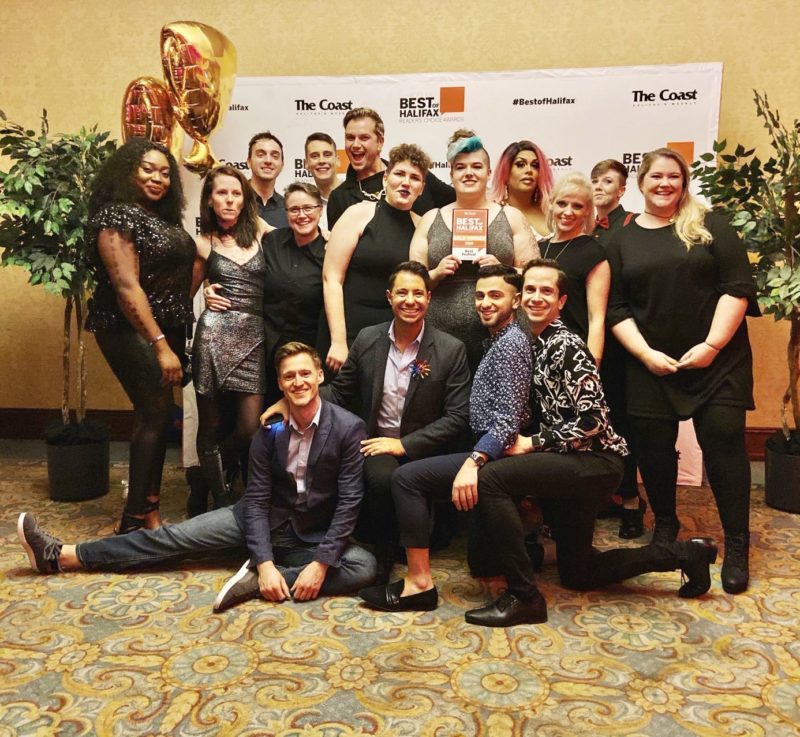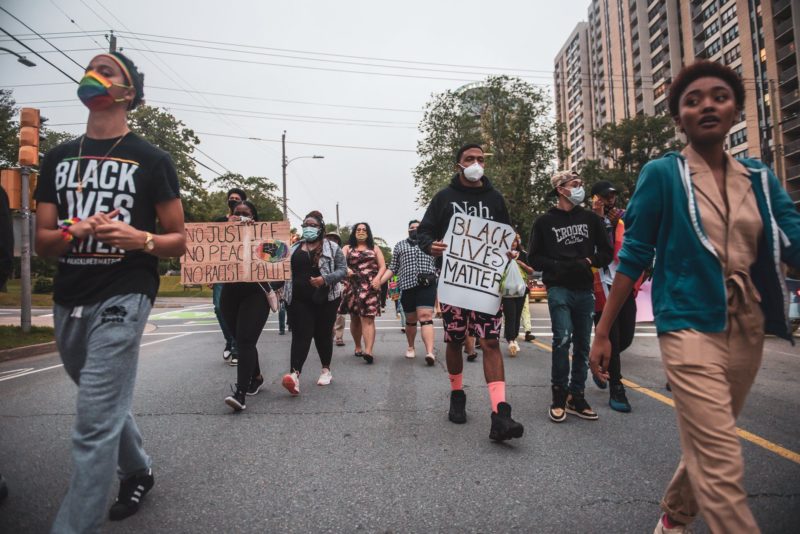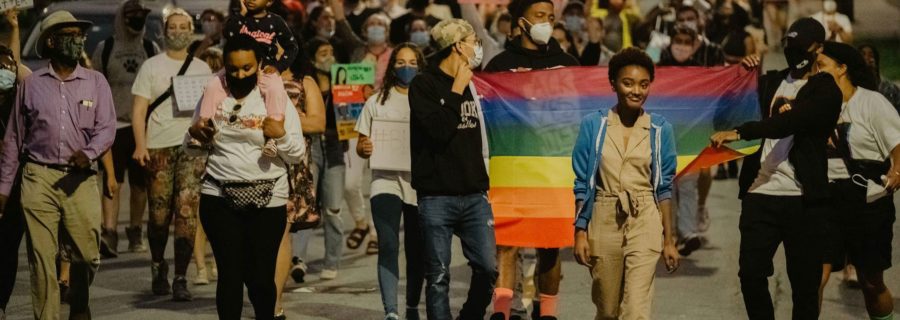Many Halifax businesses participate in Pride month every July and show their support for the 2SLGBTQIA+ community. The support ranges from marching in a parade with a giant float, changing their logos or selling a rainbow themed line of merchandise to generating fundraisers, displaying inclusive advertising or simply putting a rainbow flag up in their shop window.
To some, this is a phenomenal way to drive forward change, acceptance and inclusion for queer people in the city and province. For others, it’s simply another example of rainbow washing for the sake of profiteering and corporate clout.
What’s rainbow washing? It’s using or adding rainbow colors and/or imagery to products, material, and/or promotions. This signals progressive support of the 2SLGBTQIA+ community, but at times it can be performative. It can earn consumer credibility but little to no effort or tangible results for queer people’s benefit.
“It’s painting our history and culture in this fantasy, which seems to have turned our struggle and story into a capitalistic brand that’s being constantly exploited,” says Gabe Squalor, Co-Owner of Outlaw Country Tattoo. “And I think as queer people, who are really into educating ourselves on queer history, where we come from and what we need, we feel it’s very complicated talking about rainbow washing.”
“I'm not always offended by a rainbow flag in somebody's window. I appreciate some form of support and visibility,” says Squalor. “But it’s a complicated feeling because these corporations have a further reach than we do, by a longshot, and can do a heck of a lot more.”
These mixed emotions stem from the dividing opinions on how opportunistic rainbow washing can be. It has been a topic of contention for a while now, but this year gained a lot of traction online. Some organizations, mainly big corporations, are profiteering from 2SLGBTQIA+ products, jumping on the rainbow-washing bandwagon. And there are questions about the true intent and authenticity behind their campaigns and the support they offer.
“I think big corporations should continue to fund pride,” says Squalor. “However, I think that they should take a step back from how they use their sponsorship platforms and should rework their values and understanding around what Pride is and means.”
“They need to be giving more money, taking less and not profiting off of pride,” says Tucker Bottomley, Co-owner of Outlaw Country Tattoo.
On one hand, it’s amazing that many corporations are showing their pride during Pride. It’s great that there is so much visibility. On the other hand, it can be rather tokenizing of 2SLGBTQIA+ people in search for the pot of gold at the end of the rainbow.

Differing opinions on rainbow-washing
“To me personally as a human, rainbow-washing looks like any organization or government entity that claims they are gay friendly when they really don’t like you,” says Liane Khoury, QTBIPOC Community Committee Lead, Halifax Pride.
“So, I look at their policies, who they're hiring, and if the CEO is giving money to anti-LGBTQ causes, then why are they at Pride? Why do they want to be here? For me, that's the biggest issue.”
Putting a rainbow up for one month every year is not allyship – it's marketing. Rainbow washing allows organizations that don't do tangible work to support 2SLGBTQIA+ communities at any other time during the year, to showcase a rainbow for Pride month and call themselves allies.
“Halifax has a history of being against Pride, but we have reconciled since then,” says Khoury. “Now, I'm on the Halifax Pride board, trying to do all the progressive work and reduce rainbow-washing practices.”
The problem with the rainbow flag today is, despite it being a beautiful symbol with a meaningful history, its usage has become so generic and watered down that people and organizations can use it to claim “allyship” without addressing or even thinking about the issues the flag represents.
“If a corporation sells Pride stuff, they better be asking permission, giving 50 per cent of the profit to the artists/creators, and using the lion's share of the rest to give back to the rainbow community or a BLM organization in their area,” says Jay Aaron Roy, Owner, Cape and Cowl Comics and Collectibles.
“We must pay attention and support the people doing the work now, and use our privileges to speak up for marginalized folks. Because now is when it matters.”
The business community needs to hold ourselves to a higher standard of allyship where 2SLGBTQIA+ people are genuinely supported and recognized. Yet at the same time, this band-wagoning of social rights to make profit is seen by some as necessary before the genuine intent to support. For example, even if one child sees a commercial with the rainbow flag and decides it is okay to be part of the 2SLGBTQIA+ community, that rainbow-washed advertisement was worth it.
Organizations jumping onto the band wagon does have impact, and it can be even more impactful by having a consistent message of inclusion and support 12 months of the year. 2SLGBTQIA+ inclusion should be a fundamental element of any organization all day, every day – and not just during Pride.
“To be an ally, you must know the history of Pride,” says Khoury. “You must know Pride started as a protest and how we got to where we are today.”
“You need to recognize that Black and Latina trans women of colour started the Stonewall uprising as a response to police brutality; to think about what it means to be from an underrepresented and repressed community that police targets all the time.”
“Most importantly, to think about what they have had to overcome to get us to where we are today!”

Listening to and working with 2SLGBTQIA+ communities
The role of organizations during Pride month is to be true allies. They shouldn’t center themselves in the conversation, but rather amplify the voices of those most marginalized and who may otherwise go unheard––more specifically queer people of color.
“A true ally is someone who understands that they'll never know everything and will never finish learning,” says Squalor. “It’s someone willing to do the learning on their own but understands they'll never be an expert.”
“They are willing to give a little extra space for queer people, share resources and also understands that queer people are complex in themselves too.”
This can include organizations passing over their social media platforms to 2SLGBTQIA+ creators for a day or host a panel discussion on an under-served topic in front of a large audience. Being a true ally means lifting up and amplifying the voices of those in the community, rather than giving their own opinions.
Moreover, organizations––especially powerful ones––can be active allies in growing the prosperity of the 2SLGBTQIA+ community and rights. They can use their privilege and financial prowess to highlight queer activists.
“Some allies are often seen as this political movement and kind of influencer type people, so they're shocked and surprised when we fall flat on certain issues or if we mess up or say the wrong thing,” says Squalor. “They're shocked and can't believe a queer person could make mistakes just like everybody else, but we are just like everybody else: complex and sometimes not going to be right.”
“True allies can recognize when it's the right time to ask questions and when it's the right time to just do their own research,” says Bottomley. “Personally, when I'm learning about a new subject I would rather ask someone, but those aren't always things that you should be asking others because you don't want to take their labor. Allies should be willing to do their own research.”
Additionally, if organizations are selling Pride merchandise and giving the profits to an organization like the Youth Project and/or making sure they’re hiring/supporting 2SLGBTQIA+ employees, that’s a good-faith effort and true allyship. If it’s only about changing logos on social media or hanging a flag in store fronts to entice queer people to spend their money, that’s when it becomes rainbow-washing.
“I find it incredibly troubling when businesses will not readdress their values and the way that they employ people and treat their employees,” says Squalor. “But then, they just throw a flag in the front of the shop without really looking at how they might be contributing to the systematic stress that queer people face at work from day to day.”
Outside of Pride month, organizations should feature 2SLGBTQIA+ people in marketing campaigns without rainbows. They should host events to amplify those historically marginalized voices all year round, as well as highlight important issues and inequalities faced by the community when the topics aren’t trending.
“Otherwise, it's just incredibly performative and trendy,” says Bottomley. “It’s saving face and simply a way to show that they’re down with the gays by just putting a rainbow in the front of the store and creating some marketing promotions.”

Building inclusive business environments
All the while, are organizations working to educate, support and address the work they need to do on behalf of the queer community? Many community members view these organizations as accepting, inclusive, welcoming and caring. In addition, they appreciate the effort and are grateful for the 365-days-a-year support.
“Pride is not just a month, or a parade. Pride can be joyful, but it is also heavy. It’s 24/7, 365 days,” says Roy. “Pride is liberation, hard work, a movement and to be respected.”
If an organization signals its pro-2SLGBTQIA+ initiatives only during Pride, there’s a good chance the support is just a marketing strategy to look good and make profits. However, if it is repeatedly discussing internal 2SLGBTQIA+ initiatives, volunteering with local queer organizations and financially contributing to them on a regular basis, there’s a much better chance its rainbow boasting is authentic.
“True allyship is when a person finds peace in setting aside their ego. It’s wanting to lift up and support the rainbow community without wanting a pat on the back,” says Roy. “It’s about listening and stepping up to defend queer people against bullies and bigots.
“A true ally doesn't stress about being corrected and introduces themselves in new groups with their pronouns to break the ice and make it easier for others.”
Being a true ally for the 2SLGBTQIA+ community is hard work. It includes repeated, consistent efforts to ensure a company’s internal culture, marketing campaigns and goals are aligned.
Organizations that undertake these initiatives and strive to reach these ideals should be the only ones displaying the rainbow flag.
“Think about all the different policies within an organization that could discriminate against queer and trans folks, for example banks,” says Khoury. “They are usually prominent at Pride, because it's very much performative, in my opinion.”
“They have all these queer and trans employees to showcase their inclusivity, but they also have these policies where trans people can't change their name on their bank accounts.”
Organizations like Canada’s LGBTQ+ Chamber of Commerce (CGLCC) help counter the challenges that queer folks face in the corporate world. CGLCC’s goal is to create an inclusive Canadian economy where 2SLGBTQIA+ businesses and entrepreneurs enjoy the same opportunities as other businesses.
“It is absolutely essential that corporations implement diversity and inclusion efforts into their business operations. One way to do this is our Supplier Diversity Program,” says Ryan Nearing, Manager, Membership & Supplier Diversity, CGLCC.
“Our Supplier Diversity Program works to fill the tables of progressive organizations looking to diversify their supply chains with innovative LGBTQ+ certified suppliers who can competitively meet their purchasing needs.”
An increased demand for diverse supply chains in both the private and public sector highlights the need for programs like the Supplier Diversity Program. The CGLCC works to promote inclusive procurement practices among contracting authorities to assure buyers that potential suppliers have an equitable chance within supply chain competition.
“Simply put, supplier diversity is an opportunity to implement diversity and inclusion best practices into general business operations,” says Nearing. “This is how you can truly and sustainably contribute to economic empowerment of the 2SLGBTQ+ community.”
On the small business side, some of these businesses are community staples, loved by their communities. They are community hubs and donate to local fundraisers, create true safe spaces, understand worker's rights and support marginalized communities.
“Queer bars, bookshops, cafés, and flower shops, and more that make our community so vibrant and special are part of what we celebrate: each other!” says Roy. “Small businesses aren't in it to show off, or get that pat on the back. They are there to work, running events, being on boards of directors, doing organization work, helping people navigate programming, creating more accessible venues, and showing representation for the youth who are watching.”
At the same time, other small businesses in the community have some or a lot more work to do. “I feel small businesses can do better and be more representative with their diverse workforce,” says Khoury.
“In instances, I tend to support more local ones who are queer owned or who are QTBIPOC owned and give them my money; rather than going to people who don't want to create change or not wanting to listen to people who are being critical of certain policies, actions or advertisements.”

Rainbow-washing’s real impact
How can businesses of all sizes manage Pride month appropriately and supportively? It’s all about longer-term support of the 2SLGBTQIA+ communities. Generally, if organizations are genuinely supportive of queer people, it’s not difficult to find how and where their support goes.
“Look at who is at the table and leading organizational policies,” says Khoury. “Do they have trans folks in managerial postings or do they have anyone who's representing BIPOC folks? Do they have African Nova Scotians in upper management? Who is able to access those policies? Are they cis white male folks?”
Furthermore, look into whether the support is year-round, transparent and measurable; do they uplift 2SLGBTQIA+ employees; are their policies aligned with UN standards of conduct; are they addressing community issues and taking feedback seriously; do they offer paid opportunities for queer folks; and are they speaking up about anti-2SLGBTQIA+ policies and misconduct.
“It's easier with smaller businesses to recognize if they're a true ally or not, or if they're truly making a difference within their small business,” says Bottomley. “Because it's so much more intimate and less complex.”
Ultimately, organizations need to be walking the talk. The standard for approval from 2SLGBTQIA+ communities has been consistently rising year over year. Rainbow washing just doesn’t cut it anymore.
“We're seeing younger generations wanting to partake less and less in Pride because of how corporate it has become,” says Squalor. “But it's fundamentally so important that it exists in the first place.”
Organizations should not completely retire the rainbow logo next year. Instead, they should double down by leading with long-term tangible actions, demonstrating authentic commitment to the 2SLGBTQIA+ community and exuding true allyship between now and Pride 2022. These steps will lead to the real pot of gold at the end of the rainbow.
This year, the Halifax Pride festival is radiating RESILIENCE. The festival is finding strength in its surrounding community, especially with the past year and its many challenges. Halifax Pride will be taking the time to celebrate, reflect and process what has been achieved and learned. They’re encouraging the community to share its pride and resilience by radiating it from August 12 to 22. #radiateRESILIENCE

< Back to Articles | Topics: Special Feature

